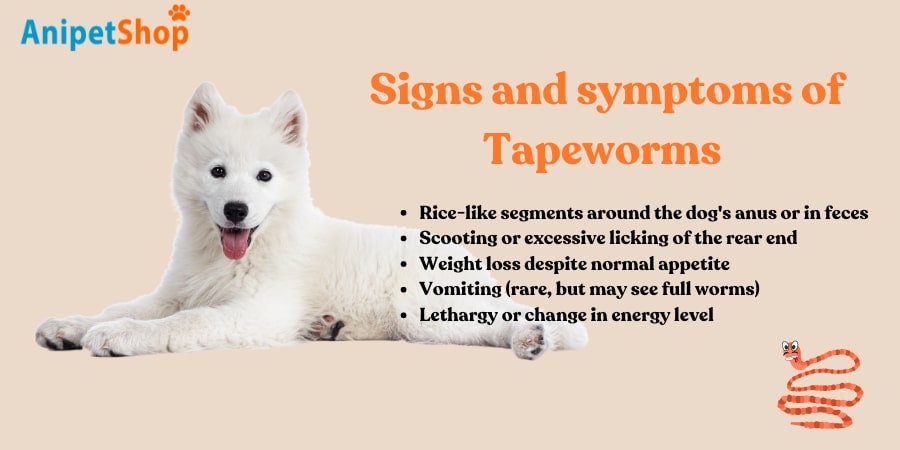Dog Tapeworms: Infecting, Symptoms, Treatment, and Prevention
When dealing with dog tapeworms, you might notice symptoms like your dog scooting, unexpected weight loss, or finding small, rice-like segments in their feces or around their rear end. Treating these parasites usually involves deworming medications prescribed by a vet, and it’s crucial to tackle any underlying flea infestations, as fleas often act as carriers. To prevent tapeworm infections, regular deworming, effective flea control, and maintaining good hygiene are key. This article will explore what tapeworms are, how they infect your dog, the associated health problems, and how to prevent these dangerous parasites.

What Causes of Tapeworms on Dogs ?
Tapeworms, scientifically known as Dipylidium caninum, are flat, common parasitic worms that can live in your dog’s body. If left untreated, a heavy tapeworm infection can cause weight loss, vomiting, and diarrhea in your pet. Fortunately, both preventing and treating tapeworms in dogs is quite simple.
A typical dog tapeworm infection follows this cycle:
- Ingestion of Infected Fleas: Dogs ingest fleas that are carrying tapeworm larvae. Fleas become infected by consuming tapeworm eggs in the environment.
- Maturation in the Intestine: Once inside the dog’s intestine, the larvae mature into adult tapeworms. Adult tapeworms can grow up to several inches long and attach to the intestinal wall.
- Shedding of Segments: As the adult tapeworm matures, it sheds segments filled with eggs into the dog’s feces. These segments may be visible and resemble grains of rice. When these segments dry out, they release the eggs.
By understanding this cycle, you can better prevent and treat tapeworm infections in your dog. Regular deworming, effective flea control, and maintaining good hygiene are key strategies in keeping your dog tapeworm-free.

Signs and Symptoms of Tapeworms in Dogs
Tapeworm infections are serious diseases that could cause some severe health problems for your dogs if pet owners do not treat them soon. Here are some signs and symptoms of dog tapeworms to watch out:
- Rice-like segments around the dog’s anus or in feces: These are mature segments of the tapeworm, filled with eggs, that have broken off and been passed in the stool. They may be white or yellowish and mobile, especially when freshly passed.
- Scooting or excessive licking of the rear end: The irritation caused by the tapeworm segments around the anus can cause your dog to scoot or lick the area excessively.
- Weight loss despite normal appetite: Tapeworms absorb nutrients from the food your dog eats, which can lead to weight loss even if your dog is eating a normal amount.
- Vomiting (rare, but may see full worms): In some cases, your dog may vomit up whole tapeworms.
- Lethargy or change in energy level: A heavy tapeworm infection can make your dog feel tired and sluggish.

Keep in mind that many dogs infected with tapeworms won’t show any signs. This is why regular checkups with your veterinarian are crucial for detecting and treating tapeworms before they cause complications.
Diagnosing Tapeworms
Diagnosing tapeworms in dogs can involve two main methods. The first one is a fairly straightforward visual examination. Owners might notice tapeworm segments, which resemble grains of rice, around the dog’s anus or in their feces. Veterinarians can confirm this by looking for these same segments during a routine check-up. The other method relies on microscopic examination of a fecal sample. While less definitive than visual identification of segments, fecal exams can reveal tapeworm eggs present in the dog’s digestive system.

Treating Tapeworms in Dogs
Tapeworm treatment in dogs is both safe and highly effective. There are a variety of medication options available, some you can even purchase over-the-counter at pet stores or online retailers. At Anipet store, there is a variety of popular tapeworm medications that could protect your dogs from this serious disease, including NexGard and Credelio.
Additionally, there are some common anti-tapeworm medications for your dogs, such as:
- Praziquantel: This tablet form of medication works by causing paralysis in the tapeworm, making it detach from the intestinal wall and be expelled from the body through the digestive system.
- Epsiprantel: It disrupts the tapeworm’s ability to maintain its attachment to the intestinal wall, leading to its expulsion from the body.
- Fenbendazole: This kind of oral medication helps interfere with the tapeworm’s ability to absorb nutrients, ultimately leading to its death.
- Piperazine: It paralyzes the tapeworms, causing them to detach from the intestinal wall and be expelled from the body.
- Drontal: This tablet form of medication contains a combination of active ingredients such as praziquantel, pyrantel pamoate, and febantel, which work together to eliminate tapeworms as well as other common parasites effectively.
Remember to consult a veterinarian before administering any medication to your dog. They can provide guidance on the appropriate dosage and treatment regimen based on the specific type of tapeworm infection.

Preventing Tapeworm Infections
Tapeworm infections are preventable and simple for pet owners to keep their dogs healthy and well-being. Here are some key measures to prevent these severe parasites:
- Regular flea control and prevention for your dog: Fleas are the intermediate hosts for the most common tapeworm in dogs. Keeping your dog on a flea preventative medication minimizes the risk of them ingesting infected fleas.
- Preventing your dog from hunting/eating rodents or other small prey: Some tapeworms can be transmitted through the consumption of infected intermediate hosts, such as rodents or rabbits. Discourage your dog from hunting and be mindful of what they scavenge during walks.
- Prompt cleanup and disposal of dog feces: Tapeworm segments can be shed in your dog’s stool. Promptly picking up after your dog helps prevent the spread of tapeworm eggs in your yard and environment.
- Regular veterinary checkups and fecal exams: Regular vet visits allow for early detection and treatment of tapeworms, protecting both your dog and your family. Fecal exams can identify the presence of tapeworm eggs or segments, even if your dog isn’t showing any symptoms.

Conclusion
Tapeworms in dogs are simply treatable and largely preventable through simple measures. Regular veterinary care by your veterinarian plays a crucial role in preventing tapeworm infections in pets. Additionally, practicing good hygiene, proper food handling, and flea control measures can effectively minimize the risk of tapeworm transmission to your dogs, ensuring a healthier environment for them.
Lily Watson is an author specializing in veterinary care in Australia. With a profound passion for animal welfare and a solid foundation in veterinary science, Lily has dedicated herself to disseminating valuable knowledge and information for both pet owners and professionals in this field.

